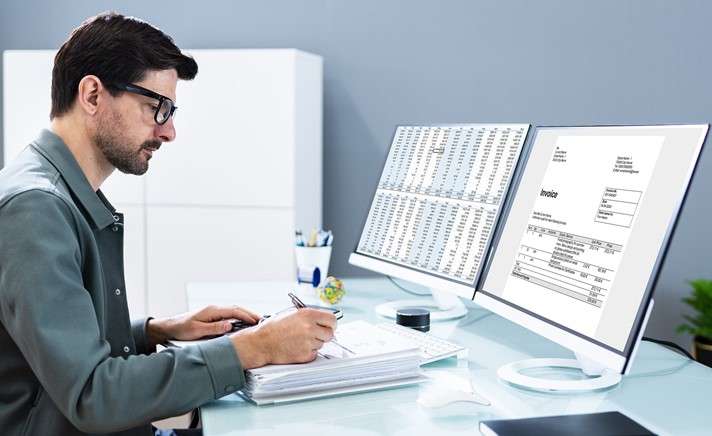
Here, we discuss the role of automation and data extraction software in invoice management systems. Read on to learn all about invoice processing, including traditional methods of invoice processing, the basics of invoice automation, and where AI fits in.
What is Traditional Invoice Processing?
Traditional accounts payable invoice processing is usually a manual, paper-based process, often drawn out into multiple steps—inputting invoice data received from multiple sources (e.g., mail, fax, and email), matching purchase orders, approval routing, filing, and more.
Within this process, accounts payable is responsible for processing invoices. Through traditional methods, this can be a very tedious task to complete. For example, traditional invoice processing often looks like this:
- Receive invoice by post or email
- Match with the purchase order
- Based on exceptions or business process rules, circulate to approvers
- After approval invoice returns to the accounts payable team
- Data is entered into the accounting system
- Final approvals
- The invoice is paid
- The invoice is archived
Depending on the company, this process can take as many as 15 separate steps to complete—which is a lengthy amount of time and has significant costs. Additionally, this process involves a lot of manual data entry and re-typing of information, which increases the chance for errors in data entry, inefficient processing, and invoices being sent to the wrong recipients for approvals.
Overall, paper invoices can take around 23 days to process if there are no issues. For invoices that have problems, this process can be drawn out up to 90 days. All these elements can create huge delays in the accounts payable process, reducing cash flow for suppliers—an especially difficult situation for smaller businesses.
What is Automated Invoice Processing?
Automated invoice processing enables businesses to streamline their accounts payable (AP) systems by processing supplier invoices automatically—rather than through traditional time-consuming manual labour.
When an invoice is received, it is scanned and fed into a digital system. Data extraction software then extracts invoice data, inputting it smoothly into your ERP (Enterprise Resource Planning) or accounts payable system so that payment processing can take place in just a matter of clicks.
For scanned documents, optical character recognition (OCR) technology converts the image into digital text while digital documents such as digital PDFs can flow straight through. Using AI technology, the data is assigned to the correct fields within the users ERP or automated accounts payable management systems. For scanned documents, without OCR, documents would be purely captured as images, meaning data would still have to be input manually.
Data capture software like Xtracta is powered by AI and machine learning, meaning the software can remember which fields to capture and register in the ERP system. Additionally, the invoice data can be extracted and mapped into accounts payable management systems which route it to the appropriate authority for review and approval.
This whole process offers exponentially faster and more efficient results.
What Invoice Management Areas Should be Automated?
Process automation can help companies effectively manage their AP invoices in a range of areas, including:
- Data entry
- Price matching
- Managing purchase orders
- Streamlining workflows
- Digital payment transfers
- And more
Compared to traditional methods of invoice processing, automation accelerates the AP process by streamlining workflows and reducing precious time spent completing menial accounting tasks.
The Benefits of Automated Invoice Processing
There are multiple advantages to consider about automated invoice processing, including:
- Greater accuracy and reduced rate of errors
- Reduces the risk of duplicate payments and invoices
- Easier to secure early payment discounts and avoid late payments
- Accelerates the approval process and reduces processing time
- Saves on labour costs
- Frees up staff time to focus on more critical tasks
- Improves the relationship between businesses and clients due to the smooth and transparent processes
- Reduces costs related to manually processing invoices (postage, paper, etc.)
Where Artificial Intelligence Fits In
Through AI and machine learning, the efficiency at which invoicing tasks are completed is significantly increased. For example, when automating invoices, AI quickly learns which tasks require judgement—such as determining the correct authority for specific invoices.
When processing data manually, invoices need to be reviewed and the information verified. AP also must spot exceptions and evaluate data on a case-by-case basis. Comparatively, when invoice processing is automated with artificial intelligence, the technology can record and verify data as well as spot potential problems at a much faster rate than manual processing.
Get in touch with Xtracta today to discuss the benefits of implementing OCR data capture technology in your company
With the right OCR data capture technology and bill scanning software, companies can easily maximise their workflow efficiency and accuracy. Xtracta offers a specialised approach to machine learning and intelligent document processing. For organisations looking to transform their accounts payable process, the Xtracta engine offers incredible document classification accuracy. Get in touch with the team today to learn more about invoice and receipt data capture possibilities with Xtracta.










